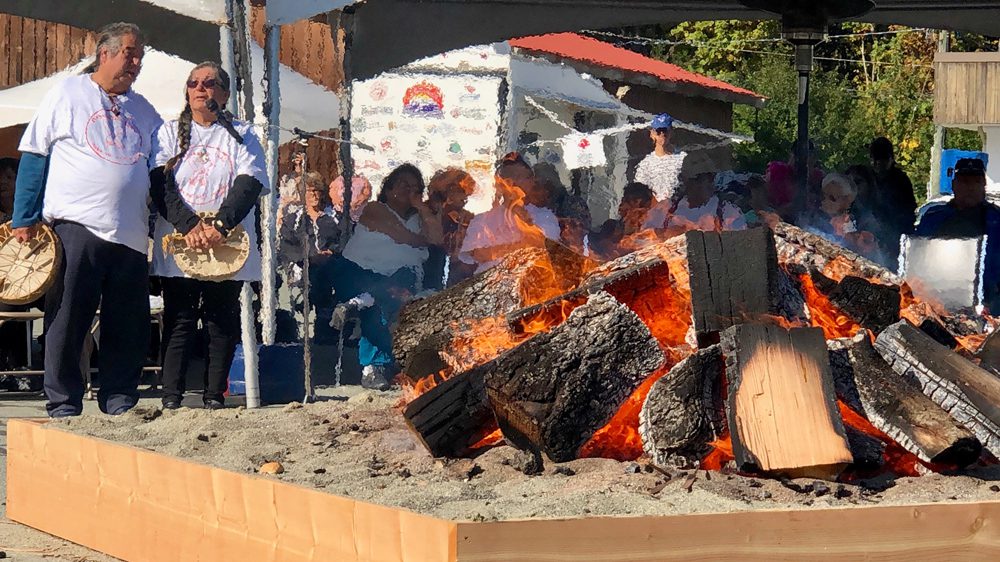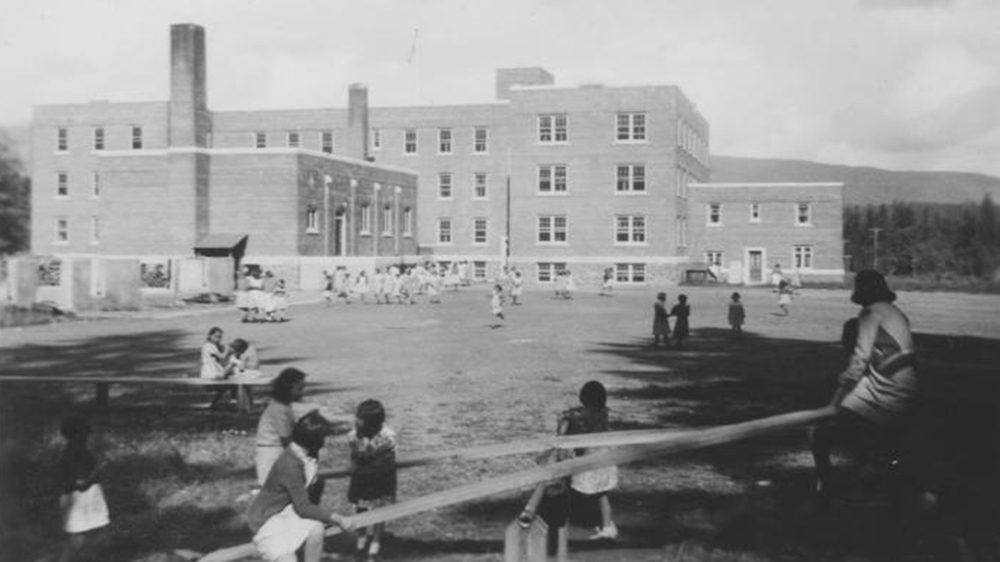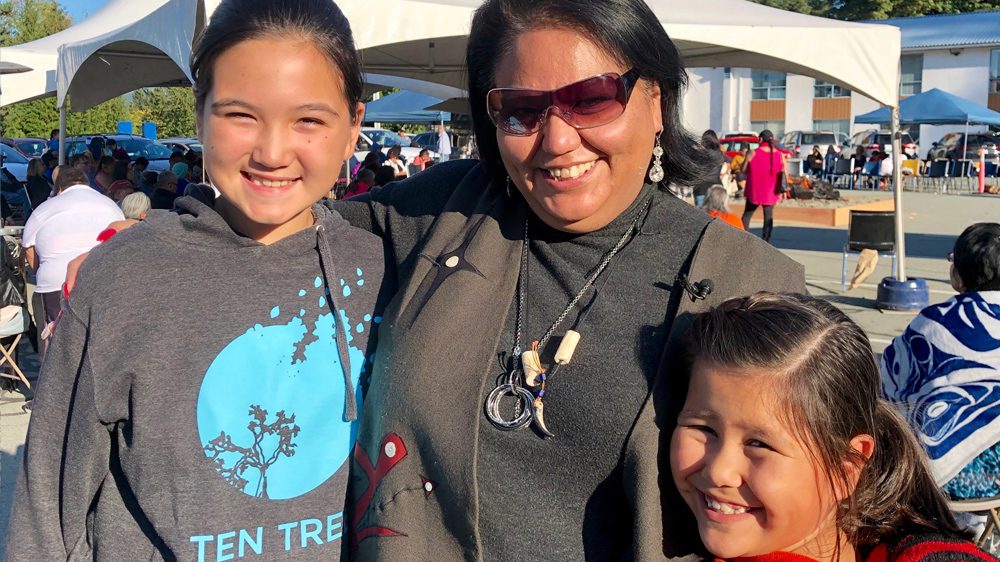Warning: This story has very emotional content and may trigger some viewers.
A spiritual fire roars at the centre of the former Alberni Indian Residential School in Tseshaht First Nation (TFN) on Vancouver Island.
Former students, survivors stand around it and pray into the flames.
“I remember going into church our Minister would slap our heads, ‘You savages, you heathens, you are nothing,’ and we felt that we were nothing,” says survivor Melvin Good from Snuneymuxw First Nation.
“We were dirty savages, we felt sad, it felt sad to be a savage.”
(Survivors of the Alberni Indian Residential School share stories, memories and singing on the grounds of the former school. Photo: Laurie Hamelin/APTN)
From 1891 – 1973 Indigenous children from all across British Columbia came to the school to be educated and assimilated, but instead they were abused, molested, and some even killed.
That nightmare still haunts generations of survivors and also the lost souls that never returned home.
Read More: Reclaiming the Lost Souls of Alberni Indian Residential School
A two day healing event, ‘Reclaiming Lost Souls of the Alberni Indian Residential School’ was hosted by TFN on September 27 and 28.
It is the first event of its kind at the site.
“You don’t have to spend too much time in any of the surrounding buildings to know that there is a presence here,” says Les Sam, the former elected Chief of TFN.
(Children play on the grounds of the Alberni Indian Residential School. Photo courtesy: Tseshaht First Nation)
There are two original buildings that are still standing, they’re being used by the community. The rest have been torn down.
“We all came to the conclusion that the lost souls didn’t speak our language and they didn’t speak English,” says Sam.
“We needed to invite all tribes in B.C. to bring their traditional language speakers to come down here on site and invite their lost souls back home where they belong.”
Sam says his people have been forced to live with a nasty mark on their traditional territory.
“Our nation didn’t have any say in having a residential school in our backyard and what they left us with is a large gaping wound in our territory,” says Sam.
Many survivors will never return to the area because the memories are too painful, but some did make it back as part of their healing journey.
Lorna Bob from Snaw-Naws-As First Nation spent two years at the school and says she came to connect with other survivors and to celebrate her indigenous culture – something historically forbidden to do.
“I felt overwhelmed with the healing,” says Bob.
“It was really strange to go through a spiritual healing, one of our cultural healings right outside where the building was.”
(Survivor Lorna Bob spent two years living in Peake Hall, the girls dorm. Photo: Laurie Hamelin/APTN)
Greg Wright drove two days from Gitxsan Territory to attend the event. He travelled with a group of survivors.
“It was really heavy listening to other stories, but we made connections because we had similar stories,” says Wright. “I was up talking today with our group. People are calling it reclaiming the soul, but to us this is reclaiming our spirit and who we are.
“I also want to bring back my brother’s spirit because he passed away and I want to free his spirit from the burdens that we all still carry.”
Wright was part of a legal challenge that took his former teacher to court for sexual abuse.
“The judge went easy on the teacher because he gave them a sob story about having to care for his elderly dad,” says Bruce Lucas.
“These guys lived a life of hell from what he had done to them. He only got two to four years concurrent.”
William Matthews was also part of the legal challenge and in 2005 participated in the Gitxsan Spirit Residential School Walk.
“We walked for days, from Prince Rupert and hit all the communities until we walked into Port Alberni,” says Matthews.
“It was to bring awareness of what happened at this school.”
(William Matthews, Archie Little, Richard Lucas, Greg Wright, Bruce Lucas. Photo: Laurie Hamelin/APTN)
Although life at residential school was hell, some students were able to find solace.
Lorna Bob even went so far as to say it felt like home.
“I felt that I was here at home within arms reach of family, my auntie was married into the Tseshaht tribe so I felt like I was at home,” says Bob.
Melvin Good took comfort in the love and support of his new family.
“We really grew up together,” says Good. “We all became family and we embraced each other.
“I love you brothers and they return that love.”
Jacqueline Watts attended the event with her granddaughters on behalf of her late mother, Linda Mae Watts (nee Williams).
Linda didn’t speak much of her five years at the school.
“I knew I had to talk on her behalf,” says Watts. “That was the biggest strongest message was, what you say matters. It’s a very strong statement because in residential school I believe she was sexually abused because she had to go give a statement and that was during the sexual abuse part.
“She never shared the story with us but we knew what the statements were about.”
(Jacqueline Watts with her granddaughters attended the event to speak on behalf of her mother. Photo: Laurie Hamelin/APTN)
Watts told the crowd of survivors that she was angry. That the government’s residential school independent assessment process opened old wounds too heartbreaking for her mother to handle.
“She never got to talk, she got sick right after that,” says Watts.
“I felt that it took her life and she was unable to share her story.”
Watts says the trauma from residential school goes far beyond the survivors.
“I never understood why things were so hard,” says Watts.
“Why I was a mother when she wasn’t. Why everybody was so angry, why sexual abuse was a norm. And we’re the next layer that needs to be looked at. The offspring of the survivors, we have a lot to say, we were hurt also.”
Survivors, family and friends of all ages opened up and shared their stories over the two days. Many people were in tears, but not just tears of sadness, there were tears of love and laughter, gratitude and inspiration.
The powerful event ended with everyone dancing and drumming into the night – proving that the resilience of Indigenous peoples can never be taken away.















